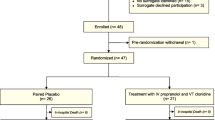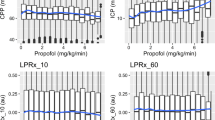Abstract
Objective
To explore the pharmacokinetics and pharmacodynamics of dopamine and norepinephrine.
Design
Prospective, controlled, trial.
Setting
Neurosciences critical care unit.
Patients
Eight patients with a head injury, requiring dopamine or norepinephrine infusions to support cerebral perfusion pressure (CPP).
Intervention
Patients received in randomised order, either dopamine or norepinephrine to achieve and maintain a CPP of 70 mmHg, and then, following a 30-min period of stable haemodynamics, a CPP of 90 mmHg. Data were then acquired using the second agent. Haemodynamic measurements were made during each period and a blood sample was obtained at the end of each study period for analysis of plasma catecholamine concentrations
Measurements and results
Plasma levels of norepinephrine and dopamine were significantly related to infusion rates but did not have a simple linear relationship to haemodynamic parameters. However, there was a significant quadratic relationship between the infusion rate of dopamine and cardiac index (r 2=0.431), and systemic vascular resistance index (r 2=0.605), with a breakpoint (at which cardiac index reduced and SVRI increased) at a dopamine plasma level of ~ 50 nM/l (corresponding to an infusion rate of ~ 15 μg·kg-1·min-1).
Conclusions
Norepinephrine and dopamine have predictable pharmacokinetics; however, those of dopamine do not fit a simple first-order kinetic model. The pharmacodynamic effects of dopamine and norepinephrine show much inter-individual variability and unpredictability. Plasma levels of dopamine appear to relate to variations in adrenergic receptor effects with break points that reflect expectations from infusion-rate related pharmacodynamics.



Similar content being viewed by others
References
Hoffman BB, Lefkowitz RJ (1990) Catecholamines and sympathomimetic drugs. In: Gillman AG, Rall TW, Nies AS, Taylor P (eds) Goodman and Gilman’s the pharmacological basis of therapeutics. Pergamon, New York, pp 187–243
Jarnberg PO, Bengtsson L, Ekstrand J, Hamberger B (1981) Dopamine infusion in man. Plasma catecholamine levels and pharmacokinetics. Acta Anaesthesiol Scand 25:328–331
MacGregor DA, Smith TE, Prielipp RC, Butterworth JF, James RL, Scuderi PE (2000) Pharmacokinetics of dopamine in healthy male subjects. Anesthesiology 92:338–346
Banner W Jr, Vernon DD, Dean JM, Swenson E (1989) Nonlinear dopamine pharmacokinetics in pediatric patients. J Pharmacol Exp Ther 249:131–133
Kellum JA, J MD (2001) Use of dopamine in acute renal failure: a meta-analysis. Crit Care Med 29:1526–1531
Padbury JF, Agata Y, Baylen BG, Ludlow JK, Polk DH, Habib DM, Martinez AM (1990) Pharmacokinetics of dopamine in critically ill newborn infants. J Pediatr 117:472–476
Juste RN, Moran L, Hooper J, Soni N (1998) Dopamine clearance in critically ill patients. Intensive Care Med 24:1217–1220
Juste RN, Panikkar K, Soni N (1998) The effects of low-dose dopamine infusions on haemodynamic and renal parameters in patients with septic shock requiring treatment with noradrenaline. Intensive Care Med 24:564–568
Zaritsky A, Lotze A, Stull R, Goldstein DS (1988) Steady-state dopamine clearance in critically ill infants and children. Crit Care Med 16:217–220
Eldadah MK, Schwartz PH, Harrison R, Newth CJ (1991) Pharmacokinetics of dopamine in infants and children. Crit Care Med 19:1008–1011
Le Corre P, Malledant Y, Tanguy M, Le Verge R (1993) Steady-state pharmacokinetics of dopamine in adult patients. Crit Care Med 21:1652–1657
Ratge D, Steegmuller U, Mikus G, Kohse KP, Wisser H (1990) Dopamine infusion in healthy subjects and critically ill patients. Clin Exp Pharmacol Physiol 17:361–369
Patel HC, Menon DK, Tebbs S, Hawker R, Hutchinson PJ, Kirkpatrick PJ (2002) Specialist neurocritical care and outcome from head injury. Intensive Care Med 28:547–553
Czosnyka M, Whitehouse H, Smielewski P, Kirkpatrick P, Guazzo EP, Pickard JD (1994) Computer-supported multimodal bed-side monitoring for neuro intensive care. Int J Clin Monit Comput 11:223–232
Smedes F, Kraak JC, Poppe H (1982) Simple and fast solvent extraction system for selective and quantitative isolation of adrenaline, noradrenaline and dopamine from plasma and urine. J Chromatogr 231:25–39
O’Connell MT, Portas CM, Sarna GS, Curzon G (1991) Effect of p-chlorophenylalanine on release of 5-hydroxytryptamine from the rat frontal cortex in vivo. Br J Pharmacol 102:831–836
Johnston AJ, Steiner LA, Chatfield D (2002) The effects of inotropes on brain tissue oxygenation. J Neurosurg Anesthesiol 14: P86
Calvey TN, Williams NE (1997) Pharmacokinetics. In: Calvey TN, Williams NE (eds) Principles and practice of pharmacology for anaesthetists. Blackwell Science, Oxford, pp 36–68
Garcia-Sainz JA, Vazquez-Prado J, del Carmen Medina L (2000) Alpha 1-adrenoceptors: function and phosphorylation. Eur J Pharmacol 389:1–12
Johnston AJ, Gunning KE (2001) The role of corticosteroids in sepsis. Br J Intensive Care Summer:57–62
Annane D (2001) Corticosteroids for septic shock. Crit Care Med 29: S117–120
Gundert-Remy U, Penzien J, Hildebrandt R, Maurer W, Weber E (1984) Correlation between the pharmacokinetics and pharmacodynamics of dopamine in healthy subjects. Eur J Clin Pharmacol 26:163–169
Roman T, Schmitz M, Polanczyk GV, Eizirik M, Rohde LA, Hutz MH (2002) Further evidence for the association between attention-deficit/hyperactivity disorder and the dopamine-beta-hydroxylase gene. Am J Med Genet 114:154–158
Norton N, Kirov G, Zammit S, Jones G, Jones S, Owen R, Krawczak M, Williams NM, O’Donovan MC, Owen MJ (2002) Schizophrenia and functional polymorphisms in the MAOA and COMT genes: no evidence for association or epistasis. Am J Med Genet 114:491–496
Zabetian CP, Anderson GM, Buxbaum SG, Elston RC, Ichinose H, Nagatsu T, Kim KS, Kim CH, Malison RT, Gelernter J, Cubells JF (2001) A quantitative-trait analysis of human plasma-dopamine beta-hydroxylase activity: evidence for a major functional polymorphism at the DBH locus. Am J Hum Genet 68:515–522
DeMille MM, Kidd JR, Ruggeri V, Palmatier MA, Goldman D, Odunsi A, Okonofua F, Grigorenko E, Schulz LO, Bonne-Tamir B, Lu RB, Parnas J, Pakstis AJ, Kidd KK (2002) Population variation in linkage disequilibrium across the COMT gene considering promoter region and coding region variation. Hum Genet 111:521–537
Vandenbergh DJ, Rodriguez LA, Miller IT, Uhl GR, Lachman HM (1997) High-activity catechol-O-methyltransferase allele is more prevalent in polysubstance abusers. Am J Med Genet 74:439–442
Sabol SZ, Hu S, Hamer D (1998) A functional polymorphism in the monoamine oxidase A gene promoter. Hum Genet 103:273–279
Payton A, Holmes J, Barrett JH, Hever T, Fitzpatrick H, Trumper AL, Harrington R, McGuffin P, O’Donovan M, Owen M, Ollier W, Worthington J, Thapar A (2001) Examining for association between candidate gene polymorphisms in the dopamine pathway and attention-deficit hyperactivity disorder: a family-based study. Am J Med Genet 105:464–470
de la Cal MA, Miravalles E, Pascual T, Esteban A, Ruiz-Santana S (1984) Dose-related hemodynamic and renal effects of dopamine in septic shock. Crit Care Med 12:22–25
Miall-Allen VM, Whitelaw AG (1989) Response to dopamine and dobutamine in the preterm infant less than 30 weeks gestation. Crit Care Med 17:1166–1169
Booker PD, Evans C, Franks R (1995) Comparison of the haemodynamic effects of dopamine and dobutamine in young children undergoing cardiac surgery. Br J Anaesth 74:419–423
Meier-Hellmann A, Bredle DL, Specht M, Spies C, Hannemann L, Reinhart K (1997) The effects of low-dose dopamine on splanchnic blood flow and oxygen uptake in patients with septic shock. Intensive Care Med 23:31–37
Day NP, Phu NH, Mai NT, Bethell DB, Chau TT, Loc PP, Chuong LV, Sinh DX, Solomon T, Haywood G, Hien TT, White NJ (2000) Effects of dopamine and epinephrine infusions on renal hemodynamics in severe malaria and severe sepsis. Crit Care Med 28:1353–1362
Acknowledgements
Dr Andrew Johnston is supported by a grant from Codman. Dr Luzius Steiner is supported by a Myron B. Laver Grant (Department of Anaesthesia, University of Basel, Switzerland) and grants from the Margarete und Walter Lichtenstein-Stiftung (Basel, Switzerland) and the Swiss National Science Foundation. He is recipient of an Overseas Research Student Award (Committee of Vice-Chancellors and Principals of the Universities of the United Kingdom). Work of the department is supported by a grant from the Medical Research Council (Grant No. G 9439390 ID56833).
Author information
Authors and Affiliations
Corresponding author
Rights and permissions
About this article
Cite this article
Johnston, A.J., Steiner, L.A., O’Connell, M. et al. Pharmacokinetics and pharmacodynamics of dopamine and norepinephrine in critically ill head-injured patients. Intensive Care Med 30, 45–50 (2004). https://doi.org/10.1007/s00134-003-2032-4
Received:
Accepted:
Published:
Issue Date:
DOI: https://doi.org/10.1007/s00134-003-2032-4




